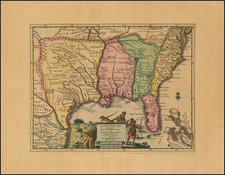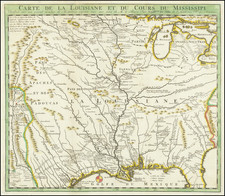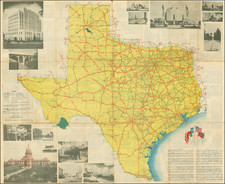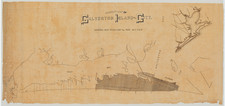One of the Holy Grails of Texana: The First Bird's-Eye View of Houston, Texas.
Only the Third Example Traced.
In 1873, Augustus Koch published a color-lithographed bird's-eye view of Houston, which, with its 9,382 residents, rivaled Galveston and San Antonio as the most populous city in Texas. By this time, railroads had connected Houston to the national railroad network, and Houstonians were eager to challenge Galveston for supremacy in Gulf shipping. Koch's view prominently features Buffalo Bayou and the railroads, symbolizing Houston's connection between the interior of the state and the outside world. Seen from the northwest, the city stretches southward from Buffalo Bayou, with shipping terminals for both the railroad and riverboats in the foreground.
Koch's depiction includes various boats populating the bayou, including rowboats, tugs, sailboats, and two riverboats—the T. M. Bagby and the Diana—both referred to as "floating palaces." White Oak Bayou flows southward into Buffalo Bayou, forming a junction opposite the foot of Main Street. Steamboats would back into White Oak Bayou to turn around for their return journey to the coast. To the east, a locomotive hauls several cars of the Galveston, Houston and Henderson Railway across a new $100,000 drawbridge. Market Hall, which opened in May 1874, is featured on Main Street and in a detail at the bottom of the print. Housing retail shops, markets, professional offices, and a 1,000-seat theater, the building unfortunately burned down just two years later.
Koch's view of Houston also highlights the African-American community by identifying two churches—although unnamed—located on Travis and Rusk streets. This attention to the African-American community is a common feature in many of Koch's works, illustrating his intention to provide a comprehensive representation of the city's population.
Rarity
The view is extremely rare and, to our knowledge, has never appeared on the antiquarian market; there are no examples recorded in RBH nor OldMaps.com
Reps (Views and Viewmakers 3978) records only two examples at the University of Texas Austin, Eugene C. Barker Texas History Center (now, Center for American History, The University of Texas at Austin), and at the Daughters of the Republic of Texas Library, San Antonio.
The popularity of the view, combined with its extreme scarcity, has given rise to a range of reproductions and copies; all but one example in OCLC seems to be a later reproduction, with only the Houston Public Library copy remaining ambiguous. Their cataloging mentions only that it is framed. In 2011, Swann Auctions sold a later blueprint of the view for $3,840.
Augustus Koch (1840-?) was one of the most prolific American engravers of Birds Eye Views working outside of the major publishing centers. Koch initially served in the Union Army during the Civil War as a clerk and draughtsman in the Engineers Office in St. Louis. Although his English was poor, he was later commissioned as an officer and assigned to one of the Black regiments serving in Mississippi where he drew maps for the advancing Union forces. By 1865 he is thought to have contracted malaria and at 25, was discharged from the army.
By 1868, Koch had become an itinerant Bird's Eye View engraver. His earliest dated views are of Cedar Falls, Vinton, and Waterloo, Iowa. At that point his career seemed to take off and in rapid succession, maps by Koch were produced in every section of the country. In 1870 he produced 5 maps in Utah, Wyoming and California. In all, Koch produced over 100 views, including over 20 Texas Views, during a career of 30 years. His last recorded view was produced in Montana in 1898.
Reps notes that while Koch engraved fewer views than some of his contemporaries, "no American viewmaker traveled more widely in search of subjects. . . "












![[Shows Republic of Texas] United States and Texas](https://storage.googleapis.com/raremaps/img/small/101139.jpg)
![La Parte Occidentale Dell'Antico, E Nuovo Messico Con Florida E La Bassa Luigiana…. 1798 [California & The Southwest!]](https://storage.googleapis.com/raremaps/img/small/95816.jpg)
